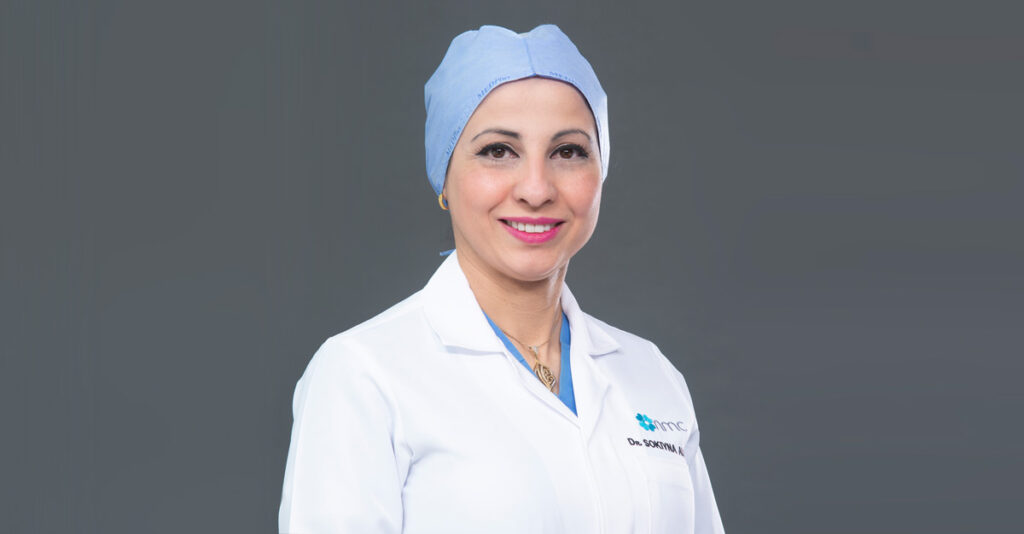Dr. Sokiyna Al Ameer
Consultant Surgeon and breast surgery specialist at NMC Royal Hospital, Khalifa City
We created the “One Stop Breast Clinic” to spread awareness and prevent cancer

The One Stop Breast Clinic provides all comprehensive care services for patients in one location, and these services are divided into non-surgical or surgical interventions. Non-surgical interventions include running tests and diagnosing the patient’s condition, as many breast fibroids are benign and breast fat may need to be monitored for a certain period of time to monitor their development and growth. If these tumors change over time or if these are complex or giant breast masses, then they are surgically removed.
Breast cysts are also a common breast condition that are monitored periodically and do not need surgical treatment; if they are large in size and painful, they are emptied with a needle without surgical treatment.
Breast abscess is treated most of the time with antibiotics, and it may need to be drained without surgical intervention, but sometimes we resort to opening it surgically if the abscess is large in size and has not been completely emptied by aspiration.
Dilation of the mammary ducts, which affects women over age 50, only needs follow-up without surgical intervention. It can be treated with antibiotics if it is accompanied by nipple discharge, redness and pain in the nipple and surrounding tissues. In some cases, a biopsy is needed to rule out breast cancer.
As for breast cancers, the breast clinic offers treatment options by experienced personnel in providing this type of care by preparing the best treatment plans depending on the type of cancer, its size, location, disease severity, laboratory test results and the patient’s general health.
Breast problems are not always cancer, but there are many benign tumors that are not dangerous, but in one way or another they cause fear and anxiety in women.
The patient’s medical history is taken, clinically examined, and then the appropriate X-rays are determined for her condition.
- Mammogram
- Breast Ultrasound
- MRI Mammography
The results of the required tests are taken on the same day, with the possibility of conducting a biopsy for cases that require this directly.
Medical conditions that require surgical treatment:
- Breast cancer and precancerous stage DCIS (Ductal carcinoma in situ)
- Phyllodes tumor and precancerous tumors due to the presence of an atypical tissue
- Complex or giant fibroadenoma
- Intraductal papilloma that grows in the milk duct
- Breast abscess that does not respond to antibiotic therapy and aspiration
- Large fatty cysts and lipomas associated with chronic pain
Breast cancer surgery is a key factor in breast cancer treatment, and it involves removing the cancer through surgery. Breast cancer surgery may be used alone or in combination with other treatments such as chemotherapy, hormone therapy, targeted therapy and radiation therapy. NMC Royal Hospital has highly experienced breast surgeons, and is working with other specialists to develop an individualized treatment approach and provide the patient with the comprehensive care she needs.
The care team includes breast cancer surgeons, oncologists, pathologists, plastic surgeons to perform the necessary breast reconstruction, physiotherapists, nurses and radiologists. The patient’s appointments are coordinated with the different specialties and often within days. If surgery is chosen first, the operation will be carried out quickly to avoid long waiting times.
State-of-the-art equipment and technologies
Diagnostic services in the clinic include:
- Mammography: An X-ray imaging method that allows the radiologist to enlarge and adjust the size, brightness and contrast to easily detect any abnormalities.
- 3D mammogram: An imaging test that combines multiple breast X-rays to create a three-dimensional picture of the breast. A 3D mammogram is used to look for breast cancer in people who have no signs or symptoms.
- Magnetic Resonance Imaging (MRI): A contrast material is used in this imaging technique to distinguish between different tissue structures in the breast. Breast MRI uses radio waves and strong magnets to make detailed pictures of the breast tissue.
- Ultrasound: This technique uses an ultrasound device on the surface of the body. The device emits sound waves that bounce off the tissues of the body to be converted into digital images that are useful for detecting any abnormalities.
- Computer-assisted breast exam: It is used in conjunction with a traditional or digital mammogram. The image is analyzed by a computer to provide the radiologist with an image of suspicious areas that require further study.
- Minimally invasive diagnostic breast biopsy: It is usually performed by a surgeon or radiologist using computer imaging to guide him in taking small tissue samples with a sterile needle.
- Vacuum-assisted stereotactic breast biopsy: A minimally invasive diagnostic technique in which a radiologist uses a suction probe inserted through a small incision to take small samples of breast tissue under the guidance of the mammogram images.
- Ultrasound-guided vacuum-assisted breast biopsy: A minimally invasive diagnostic technique in which a radiologist uses a suction probe inserted through a small incision to take small samples of breast tissue guided by the ultrasound images.
Surgery Techniques
Women with early stage breast cancer may undergo breast-conserving surgery (lumpectomy), in which only the tumor is removed from the breast while preserving the breast. The choice between mastectomy and lumpectomy can be difficult. Both measures are equally effective in preventing recurrence of breast cancer. However, lumpectomy is not an option for all breast cancer patients, and mastectomy is preferred by others. We have mastectomy techniques that preserve breast skin and allow for a more natural breast appearance following the procedure. This is also called a skin-sparing mastectomy.
Nipple sparing and areola sparing mastectomy where only breast tissue is removed while preserving the skin, nipple and areola.














